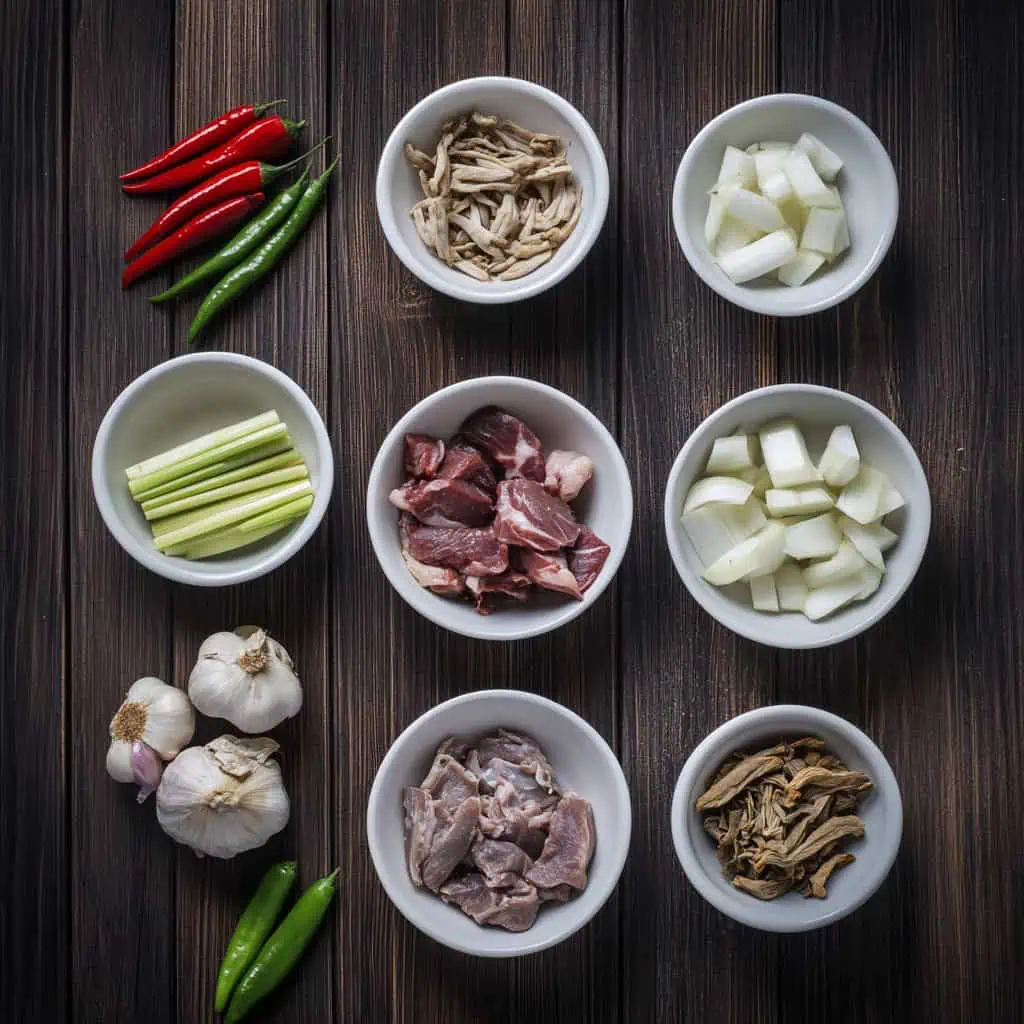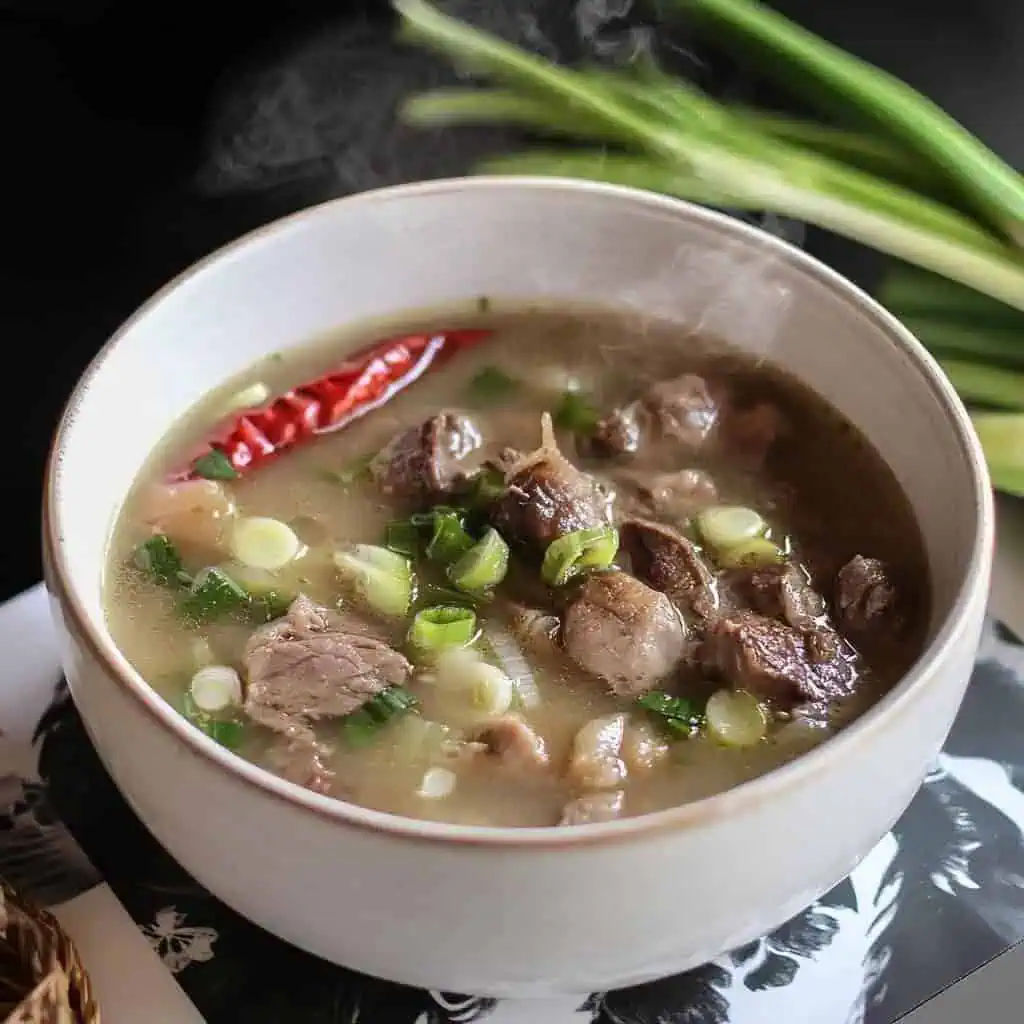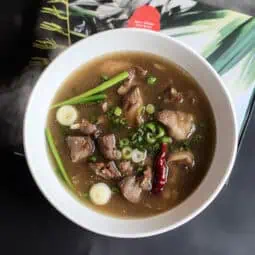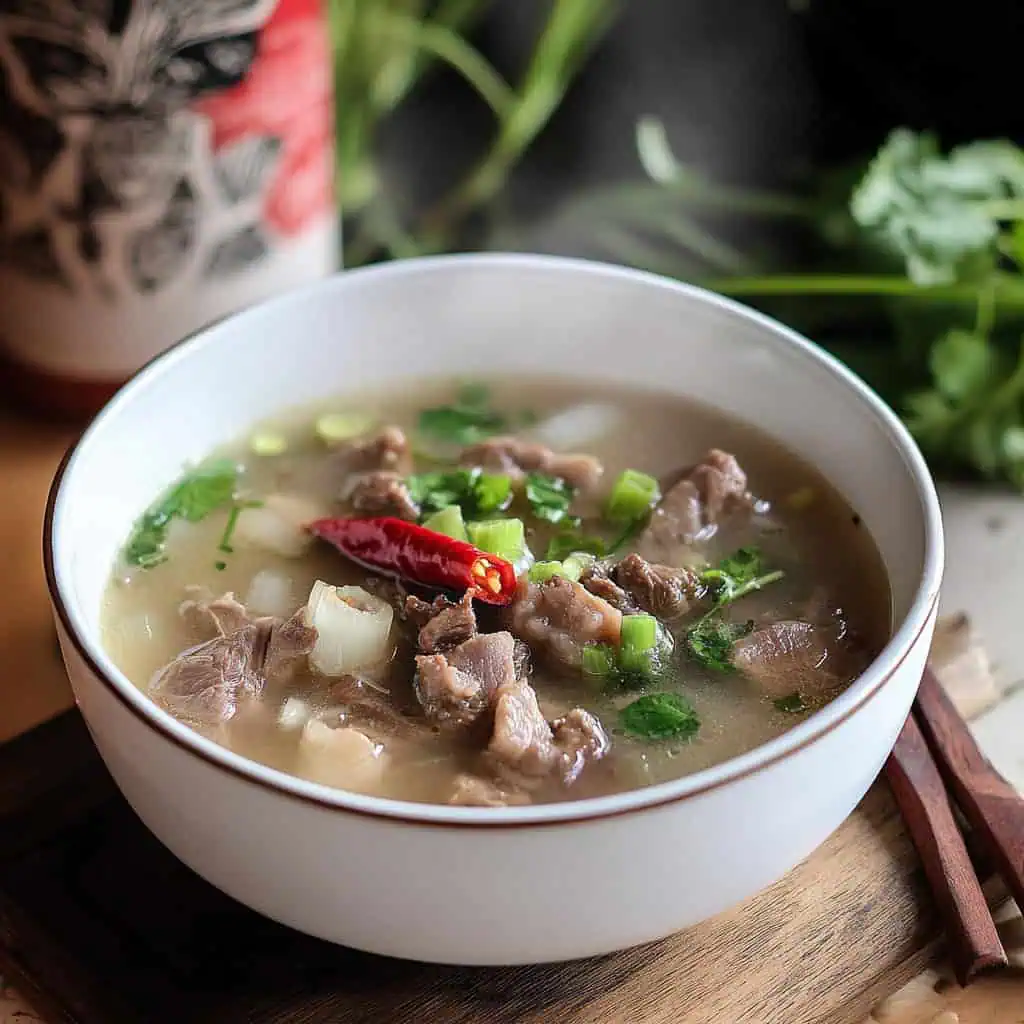First time I encountered Soup Number 5 was at Balaw Balaw, that quirky restaurant in Angono known for its exotic Filipino dishes. Perched on a plastic stool, surrounded by folk art and the buzz of local chatter, I watched steam rise from a bowl of clear, aromatic broth.
The owner, grinning, explained its "special" ingredients while ladling out portions. One sip of that rich, herb-infused soup – fragrant with ginger and lemongrass, and I understood why this dish has become legendary in Filipino drinking culture.
Just don't ask what's in it until after you've finished your bowl.
Jump to:

Why You'll Love This Recipe
- Authentic blend of Filipino and Chinese culinary traditions
- Rich in collagen and nutrients
- Perfect balance of medicinal herbs and savory flavors
- Traditional hangover remedy
- Complex depth of flavor from long simmering
Ingredients
Each ingredient in Soup Number 5 serves a specific purpose in creating its legendary flavor and benefits. The bull's testes provide unique proteins and a distinctive richness, while beef tendons add collagen for a silky mouthfeel.
The aromatic combination of lemongrass, ginger, and garlic cuts through the richness and balances the gamey notes. Sibot herbs deliver the medicinal properties this soup is famous for, with birds eye chilies adding a warming heat that activates the herbs' benefits. Fish sauce contributes umami depth without overpowering the delicate flavors.
Together, these ingredients create a perfectly balanced soup that's both nourishing and distinctive.

- 800g bulls' testes and testicles, cleaned and parboiled
- 200g beef tendons
- 4 cups beef stock
- 4 cups water
- 2 cups beef broth
- 8 stalks lemongrass, bruised
- 1 packet sibot/sibut herb mix (Chinese medicinal herbs)
- 4 birds eye chilies
- 2 thumb-sized pieces of ginger, thinly sliced
- 2 white onions, chopped
- 1 whole head garlic, minced
- 2 stalks spring onions, white and green parts separated and chopped
- Fish sauce to taste
- Freshly ground black pepper
- Cooking oil
Equipment
- Large Stock Pot (8-10 quart): Essential for the long simmering process that develops the rich flavors and allows enough room for all ingredients to cook properly
- Sharp Chef's Knife and Cutting Board: For precise preparation of meat and aromatics, ensuring consistent cooking
- Fine Mesh Strainer: To effectively separate the solid herbs from the broth while retaining all the flavors
- Heavy-Bottom Sauté Pan: Provides even heat distribution when sautéing aromatics, preventing burning and developing proper flavor
- Measuring Cups and Spoons: Ensures accuracy in ingredient portioning for balanced flavor
- Large Mixing Bowl: For cleaning and parboiling the meat
- Kitchen Tongs: Helps with handling hot meat during the cleaning and parboiling process
- Ladle: For serving the finished soup with equal distribution of solids and broth

How To Make
- Prepare the meat: Clean the bull's testes and tendons thoroughly in salted water. Cut into large chunks. Parboil twice in fresh water to remove any gamey taste, about 5 minutes each time, discarding the water between boilings.
- Start the broth base: In a large pot, combine the parboiled meat, tendons, water, beef stock, bruised lemongrass stalks, and sibot herbs. Bring everything to a boil on high heat. Once boiling, lower the heat and cover. Let it simmer gently for 3.5 hours until the meat becomes very tender.
- Prepare aromatics: While waiting, slice your ginger thinly, chop the onions, mince the garlic, and cut the spring onions, keeping the white and green parts separate.
- Process the meat and broth: Once the meat is tender, remove it from the broth and cut into bite-sized pieces. Strain the broth and discard the lemongrass and herbs. Reserve the broth.
- Build flavor base: Heat a clean pot with some oil over medium heat. Sauté the garlic first until light golden. Add the onions and white parts of spring onions, cooking until soft. Add the ginger and cook until fragrant, about 1-2 minutes.
- Combine and finalize: Return the sliced meat and tendons to the pot. Add the chilies and cook everything together for 2 minutes. Pour in your reserved broth. Bring to a boil, then reduce heat and simmer for 30 minutes to allow flavors to meld together.
- Season: Add fish sauce to taste and plenty of freshly ground black pepper. Simmer for 5 more minutes.
- Serve: Ladle hot soup into bowls, garnish with the reserved green parts of spring onions. Serve immediately.

Tips from Lola's Kitchen
- Double Parboiling Technique: Always parboil the meat twice, changing the water each time. This crucial step removes strong gamey flavors (malansa) and results in a cleaner-tasting soup.
- Ingredient Selection: Choose fresh, pink-colored testes for the best quality and flavor. The color indicates freshness and will produce a superior soup.
- Ginger Balance: Add ginger generously (more than you think you need) to properly balance the medicinal herbs. This creates harmony between the medicinal notes and savory elements.
- Resting Period: Allow the soup to rest for 10 minutes off the heat before serving. This short rest allows the flavors to fully integrate and develop.
- Bruising Technique: Properly bruise the lemongrass by gently pounding it with the back of a knife. This releases essential oils without breaking the stalks, making them easier to remove later.
- Layered Cooking: Building flavor in stages (parboiling, long simmering, sautéing aromatics, final simmer) is essential for developing the soup's characteristic depth.
Substitutions
- Sibut Herb Alternatives: If you can't find a traditional sibut mix, create your own with dried shiitake mushrooms, goji berries, astragalus root, and a small piece of dried tangerine peel. This provides similar medicinal qualities and flavor complexity.
- Meat Options: Beef tendons can be replaced with oxtail for a different texture but similar collagen content. For those wanting to avoid the traditional ingredients altogether, beef shank or brisket can be substituted, though the soup will have a different character.
- Chili Adjustments: Regular red chilies can replace birds eye chilies for a milder heat level while maintaining the warming quality that complements the medicinal herbs.
- Broth Base: If homemade beef stock isn't available, use high-quality store-bought beef bone broth with additional beef bouillon for depth. Add 1-2 beef marrow bones during simmering for extra richness.
- Lemongrass Alternative: In a pinch, combine lemon zest and a stalk of chopped celery to approximate lemongrass's aromatic quality.
Troubleshooting
- Too Bitter: If the soup tastes overly bitter from the herbs, add more ginger and onions to balance the flavor. A teaspoon of brown sugar can also help counteract excessive bitterness without making the soup sweet.
- Excessive Gaminess: If the meat still tastes gamey despite parboiling, remove it from the soup, parboil once more in fresh water with sliced ginger, then return to the soup. Continue simmering for an additional 30 minutes.
- Broth Too Thin: For a thicker, more substantial broth, extend the final simmering time by 15-20 minutes uncovered. Alternatively, remove some meat, blend it with a little broth, and return to the pot for natural thickening.
- Too Spicy: If the heat level is overwhelming, remove chilies before the final simmer. Adding a splash of coconut milk or a small amount of butter can also help temper excessive spiciness.
- Cloudy Broth: If your broth lacks clarity, strain it through a fine-mesh strainer lined with cheesecloth, then return to heat before adding the final ingredients.
- Under-seasoned: Boost flavor with incremental additions of fish sauce rather than salt. Let each addition simmer for 2-3 minutes before tasting again, as fish sauce flavor develops with heat.
Storage & Reheating
- Refrigeration: Store cooled soup in airtight containers for up to 3 days in the refrigerator. The flavor actually improves overnight as the herbs and spices continue to infuse.
- Freezing Method: For longer storage, freeze in portion-sized containers for up to 2 months. Leave 1-inch headspace to allow for expansion.
- Proper Thawing: Thaw frozen soup overnight in the refrigerator for best texture preservation.
- Gentle Reheating: Reheat slowly on the stovetop over medium-low heat (around 90°C/195°F) until just simmering. Avoid boiling vigorously which can toughen the meat.
- Flavor Refresh: When reheating, add fresh spring onions and a small amount of thinly sliced ginger to revitalize the aromatic qualities that diminish during storage.
- Consistency Adjustment: If the soup thickens after refrigeration, add a small amount of beef broth when reheating to restore the original consistency.
- Serving After Storage: Always serve reheated soup steaming hot to experience the full aroma and flavor profile.

FAQ
Why is it called Soup Number 5?
This soup earned its name from being listed as menu item #5 in traditional Filipino-Chinese restaurants, after the more common soup varieties. The numbering system provided discretion about the unusual ingredients.
What exactly are sibut herbs?
Sibut (or sibot) is a traditional Chinese medicinal herb mixture typically containing Angelica Root, Rehmannia, White Peony Root, Goji Berries, and other herbs known for their warming and invigorating properties. The specific blend may vary between herb shops.
How do I properly clean and prepare the main ingredients?
First soak in cold, salted water for 30 minutes. Rinse thoroughly, then parboil twice in fresh water for 5 minutes each time, discarding the water between boilings. Remove any membranes or connective tissue before the final cooking.
What's the best time to serve this soup?
Traditionally, Soup Number 5 is served late evening as pulutan (bar food) or early morning as a revitalizing breakfast, particularly after a night of drinking. It's believed to provide energy and vitality at these times.
Are there any health benefits to Soup Number 5?
The soup is high in protein and collagen, which supports joint health. Its traditional Chinese herbs have been used for centuries to boost energy and stamina. The warming properties of the soup are believed to improve circulation.
Can I make this soup less spicy while maintaining its authentic character?
Yes, you can reduce the number of chilies or remove them after brief cooking to impart just a hint of heat. The essential character comes from the herbs and meat rather than the spice level.
How can I tell when the meat is perfectly cooked?
The meat should be tender enough to easily pull apart with chopsticks or a fork, but should still maintain its structure when sliced. Overcooked meat will become grainy in texture.
What makes the broth cloudy and how can I prevent this?
Rapid boiling causes proteins and fats to emulsify into the broth, creating cloudiness. Maintain a gentle simmer throughout the cooking process for a clearer broth. Skimming the surface occasionally also helps.
Can I prepare components of this dish ahead of time?
Yes, the meat can be cleaned, parboiled and refrigerated up to a day ahead. The broth base can also be prepared in advance and refrigerated, with the final sautéing and flavor-building steps done just before serving.
Related
Looking for other recipes like this? Try these:

Filipino Soup Number 5 (Lansiao)
Equipment
- Large stock pot (para sa mahabang pagluluto) for long simmering
- Sharp knife and cutting board (kutsilyo at sangkalan) for precise ingredient preparation
- Fine mesh strainer (pangsala) for straining herbs
- Heavy-bottom sauté pan (kawali) for sautéing aromatics
- Measuring cups and spoons (Panukat) for accurate portions
Ingredients
Primary Ingredients:
- 800 g bulls' testes and testicles bayag ng toro, cleaned and parboiled
- 200 g beef tendons litid
- 4 cups beef stock sabaw ng baka
- 4 cups water tubig
- 2 cups beef broth sabaw ng baka
Aromatics and Herbs:
- 8 stalks lemongrass tanglad
- 1 packet sibot/sibut herb mix halamang intsik
- 4 birds eye chilies siling labuyo
- 2 thumb-sized ginger luya
- 2 white onions sibuyas
- 1 whole head garlic bawang
- 2 stalks spring onions sibuyas dahon
Seasonings:
- Fish sauce patis to taste
- Freshly ground black pepper paminta
- Cooking oil mantika
Instructions
- First, clean the bull's testes and tendons thoroughly in salted water. Cut into large chunks. Parboil twice in fresh water to remove any gamey taste, about 5 minutes each time.
- In a large pot, combine the parboiled meat, tendons, water, beef stock, bruised lemongrass stalks, and sibot herbs. Bring everything to a boil on high heat. Once boiling, lower the heat and cover. Let it simmer gently for 3.5 hours until the meat becomes very tender.
- While waiting, prepare your aromatics. Slice your ginger thinly, chop the onions, mince the garlic, and cut the spring onions, keeping the white and green parts separate.
- Once the meat is tender, remove it from the broth and cut into bite-sized pieces. Strain the broth and throw away the lemongrass and herbs. Keep the broth.
- Get a clean pot and heat some oil over medium heat. Cook the garlic first until it turns light golden. Add the onions and white parts of spring onions, cooking until soft. Add the ginger and cook until you can smell its aroma.
- Put the sliced meat and tendons back in. Add the chilies and cook everything together for 2 minutes.
- Pour in your saved broth. Let it come to a boil, then reduce heat and simmer for 30 minutes so the flavors can come together.
- Add fish sauce to taste and plenty of freshly ground black pepper. Give it 5 more minutes to simmer.
- Serve hot in bowls, topped with the green parts of spring onions you saved earlier.
- This soup tastes best piping hot and is perfect as a late-night dish or early morning pick-me-up.
Tips from Lola's Kitchen
- Parboil meat twice to remove strong gamey flavors (malansa)
- Choose fresh, pink-colored testes for best quality
- Add ginger generously to balance medicinal herbs
- Let soup rest 10 minutes before serving for flavors to meld
Nutrition
The Story Behind Soup Number 5 (Lansiao)
The origins of Soup Number 5 weave through Manila's bustling Binondo district, where Filipino-Chinese communities first introduced this intriguing dish. Originally listed simply as "No. 5" on restaurant menus—after standard soups like chicken, pork, beef, and seafood—this discrete numbering cleverly masked its unique ingredients while piquing diners' curiosity.
The soup's Chinese name, lansiao, comes from Hokkien dialect, directly referencing its main ingredients. Early Hokkien immigrants brought their traditional medicinal soups, including the crucial sibut herb mixture containing Angelica Root, Rehmannia, and Goji Berries. These herbs, combined with Filipino cooking techniques like sautéing aromatics, created a distinctive fusion that became a staple in Manila's late-night eateries.
What sets this soup apart is its transformation from a modest medicinal brew to a celebrated street food phenomenon. In Cebu's bustling corners and Manila's vibrant food districts, it gained fame as both a hangover cure and an aphrodisiac. Local lore suggests that Chinese merchants initially prepared it for strength and vitality during long trading voyages, later sharing it with Filipino dock workers and laborers.
Today, Soup Number 5 represents the enduring influence of Chinese cuisine on Filipino food culture. While some establishments still maintain the mysterious "Number 5" moniker, others proudly showcase it as a testament to Filipino culinary adventurousness. From humble beginnings in immigrant kitchens to its current status as a notorious delicacy, this soup embodies the bold, diverse character of Filipino street food heritage.










Comments
No Comments